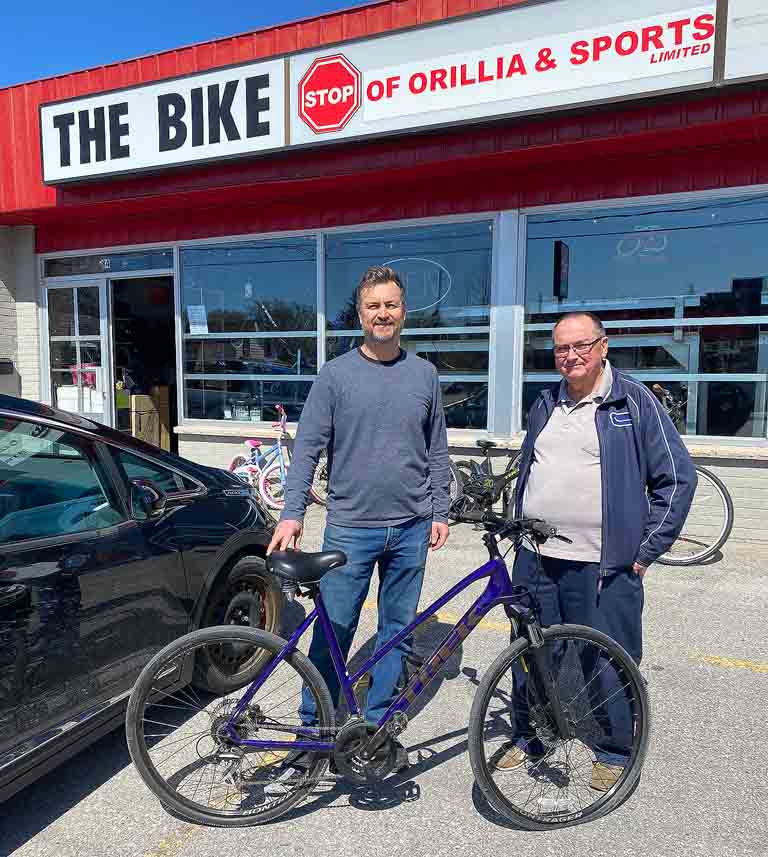Spring Is Here. Time To Get Your Wheels In Gear
By Paul Belanger and Gord Ball – Special to SUNonline/Orillia
As we announced last week, Sustainable Orillia is once again working with the Simcoe-Muskoka Health Unit and local bike shops to present an expanded bike challenge from May 11 to June 8.
This year’s event, Sustainable Spokes – Healthy Folks launched April 26 with a kick-off event at the Orillia Recreation Centre. Attendees of this event received instructions, rules of the contest, bicycle trail maps, and safety tips
Sustainable Orillia director Dave VanAlstyne welcomed 30 participants. Participants in the challenge will log their trips by bicycle between May 11 and June 8.
Organizers emphasize that this is not a race but a personal challenge for participants to do their best to ride instead of driving or being driven in a car to work or school.
Total kilometres and number of trips will be counted, leading to prizes for winning individuals and teams of three. Every trip counts in this challenge – even trips to the grocery store, going for a pleasure ride around town or on trails.
The goal is to collectively log at least 7,560 kms – the distance across Canada – over the course of the challenge. Prizes will be awarded to those with the highest totals.

Charlotte Knegt of the Simcoe Muskoka District Health Unit, was on hand for a presentation on the health and social benefits of cycling (there are at least 11).
“More people are choosing active transportation more frequently – bikes are especially great for short trips,” she said.
Municipal councillors from Orillia, Oro-Medonte, Severn and Ramara were on hand to contribute to the event launch. Orillia councillor Jay Fallis spoke of the progress the City is making with dedicated bike lanes, while noting that there is still much more to be done. Fallis rode his own bike to the launch, and said he was “looking forward to logging more kilometres over the next few weeks.”
Oro-Medonte councillor John Bard spoke of the many cycling trails in his township and throughout Simcoe County. He said the bike challenge as a “brilliant initiative” and hoped that it would encourage people to enjoy the outdoors and promote good health, while saving money.
Severn Township cyclist Matt Thomson noted that cycling is a great way for people to get out and explore their own neighbourhoods, and beyond. Matt rides his bike daily, year-round.
Getting Your Bicycle Ready for Spring

If you are planning to ride your bicycle to work or school, ensuring your bike is in good condition is crucial for a smooth, safe and dependable ride. Follow the tips below from Paul Belanger, owner of the Bike Stop in Orillia.
1. Clean and Check for Wear and Tear. Begin by giving your bike a thorough cleaning. Use a gentle brush, mild detergent, and water to scrub away grime, dirt, and salt residue that might have accumulated during winter rides (or dust while stored for the winter). Pay close attention to the drivetrain, chain, cassette, and derailleurs – a biodegradable degreaser may be required to clean these parts. A clean bike looks better and performs more efficiently.
While cleaning, inspect your bike for any signs of wear and tear. Check the brake pads for wear, ensuring they make full contact with the rims or discs. Look for cracks, dents, or rust on the frame, fork, and wheels. Tighten any loose bolts and, if you’re unsure about any part, consult with a bike mechanic for a professional assessment.
2. Inflate the Tires. Proper tire pressure is essential for a comfortable and efficient ride. Check the recommended tire pressure range, usually printed on the sidewall of the tire. Use a floor pump with a pressure gauge to ensure they are inflated correctly. Under-inflated tires can lead to sluggish handling and increased risk of flats, while over-inflated tires can make for a harsh and uncomfortable ride. Inspect the tires for any cuts, punctures, or embedded debris that could cause flats. Replace tires if the tread is worn down, the tire is cracking or if you notice any significant damage.
3. Lubricate. Proper lubrication is key to keeping your bike running smoothly and extending the lifespan of its components. Apply lubricant to the entire chain, wiping off any excess to prevent attracting dirt and grime. A well-lubricated chain ensures crisp shifting and reduces wear on the drivetrain. A good quality dry lube is best unless you regularly ride in wet weather or during the winter, in which case a wet lube will provide better protection. It is crucial to avoid getting any lubricant on disc brake components.Inspect the pedals, bottom bracket, and headset for any signs of dryness or corrosion. Listen for any creaking or groaning that may indicate the parts may need to be regreased or replaced.
4. Check the Brakes. Your brakes are the most critical safety feature on your bike. Inspect the brake pads for wear, ensuring there is enough material to make full contact with the rims or discs. Adjust the brake pads if necessary to align them properly. If your disc brakes are squealing or lacking stopping power, it may be time to replace pads or rotors. Test the brake levers to ensure they engage smoothly and with enough force to stop your bike effectively. If you notice any sponginess or if the brakes don’t engage as they should, it might be time to replace the brake cables or bleed hydraulic brakes.
5. Check the Shifting. Smooth shifting will make your rides more enjoyable and efficient. It’s the kind of thing you take for granted until your drive train starts making an annoying noise or won’t shift properly. Check the shifting of your gears, ensuring they move cleanly through the entire range without skipping or hesitating. If you notice any issues, you can adjust the cable tension using the barrel adjusters on the shifters or derailleurs or seek help from your local bike mechanic.
Remember that safety is paramount, so always wear a properly fitted helmet, use lights and reflectors when riding in low-light conditions, and obey traffic laws and road etiquette.
Commuting by Bicycle Checklist
If you’re planning to commute to work or school by bicycle, there are a few essential items that you should consider having:
- A bicycle: This is obvious, perhaps, but you need a reliable bicycle that fits you, is comfortable to ride, and is suited to your commuting needs.
- Helmet: Protect your head by wearing a properly fitting helmet. It can significantly reduce the risk of injury in the event of an accident. Helmet manufacturers recommend replacing your helmet every five years as the internal foam hardens and becomes less effective at absorbing impacts. If you have had a crash and your helmet hit the ground, you need to replace it. You only get one brain, protect it.
- Lights: If you’re commuting early in the morning or late at night, you should have a set of lights on your bike so you can see and be seen by other road users. Even during the day, a flashing light on the front and back ensures drivers notice you.
- Lock: A good quality lock is essential to keep your bike safe and secure when you’re not riding it. If you have quick release wheels, be sure to secure the wheels as well as the frame of the bike.
- Fenders: If you plan to commute rain or shine, fenders are essential to keep the water and mud from splashing onto you and your clothes. Even if you don’t plan to commute in the rain, weather can be unpredictable.
- Panniers or backpack: A bag or pannier is necessary to carry your work clothes, lunch, and other essentials.
- Water bottle: Stay hydrated, especially if you have a longer commute.
Safe riding, everyone.
(Images Supplied)




